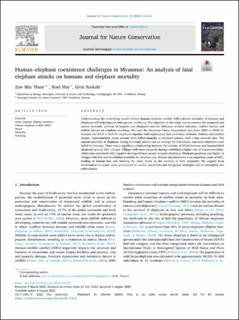| dc.contributor.author | Thant, Zaw Min | |
| dc.contributor.author | May, Roelof Frans | |
| dc.contributor.author | Røskaft, Eivin | |
| dc.coverage.spatial | Myanmar | en_US |
| dc.date.accessioned | 2022-08-25T12:50:38Z | |
| dc.date.available | 2022-08-25T12:50:38Z | |
| dc.date.created | 2022-08-22T08:45:46Z | |
| dc.date.issued | 2022 | |
| dc.identifier.issn | 1617-1381 | |
| dc.identifier.uri | https://hdl.handle.net/11250/3013586 | |
| dc.description.abstract | Understanding the underlying causes behind human–elephant conflict (HEC)-driven mortality of humans and elephants will help improve both parties’ wellbeing. The objective of this study was to examine the temporal and spatial mortality patterns of humans and elephants and the influence of local attitudes, conflict factors and habitat factors on elephant poaching. We used the Myanmar Forest Department data from 2001 to 2020 for humans and 2011 to 2020 for elephants together with explanatory data on human attitudes, habitat, and conflict factors. Approximately seven persons were killed annually in elephant attacks, with a bias towards men. The annual mortality of elephants during the study period was on average 16 individuals, and most elephants were killed by humans. There was a significant relationship between the number of killed humans and human-killed elephants around HEC villages. Villages with more property damage exhibited a higher rate of human mortality, which also correlated with negative feelings of local people towards elephants. Elephant poaching was higher in villages with less suitable habitat available for elephant use. Human encroachment is an important cause of HEC, leading to human loss and forming the main threat to the survival of wild elephants. We suggest local involvement to ensure good governance in conflict resolution and mitigation strategies and to strengthen law enforcement. Asian elephant (Elephas maximus) Human–elephant conflict (HEC) Attack Mortality Poaching | en_US |
| dc.language.iso | eng | en_US |
| dc.rights | Navngivelse 4.0 Internasjonal | * |
| dc.rights.uri | http://creativecommons.org/licenses/by/4.0/deed.no | * |
| dc.subject | Asian elephant (Elephas maximus) | en_US |
| dc.subject | Human–elephant conflict (HEC) | en_US |
| dc.subject | Attack | en_US |
| dc.subject | Mortality | en_US |
| dc.subject | Poaching | en_US |
| dc.title | Human–elephant coexistence challenges in Myanmar: An analysis of fatal elephant attacks on humans and elephant mortality | en_US |
| dc.title.alternative | Human–elephant coexistence challenges in Myanmar: An analysis of fatal elephant attacks on humans and elephant mortality | en_US |
| dc.type | Peer reviewed | en_US |
| dc.type | Journal article | en_US |
| dc.description.version | publishedVersion | en_US |
| dc.rights.holder | © 2022 The Authors | en_US |
| dc.subject.nsi | VDP::Zoologiske og botaniske fag: 480 | en_US |
| dc.subject.nsi | VDP::Zoology and botany: 480 | en_US |
| dc.source.volume | 69 | en_US |
| dc.source.journal | Journal for Nature Conservation | en_US |
| dc.identifier.doi | 10.1016/j.jnc.2022.126260 | |
| dc.identifier.cristin | 2044783 | |
| dc.relation.project | Andre: Norwegian Environment Agency | en_US |
| dc.source.articlenumber | 126260 | en_US |
| cristin.ispublished | true | |
| cristin.fulltext | original | |
| cristin.qualitycode | 1 | |

